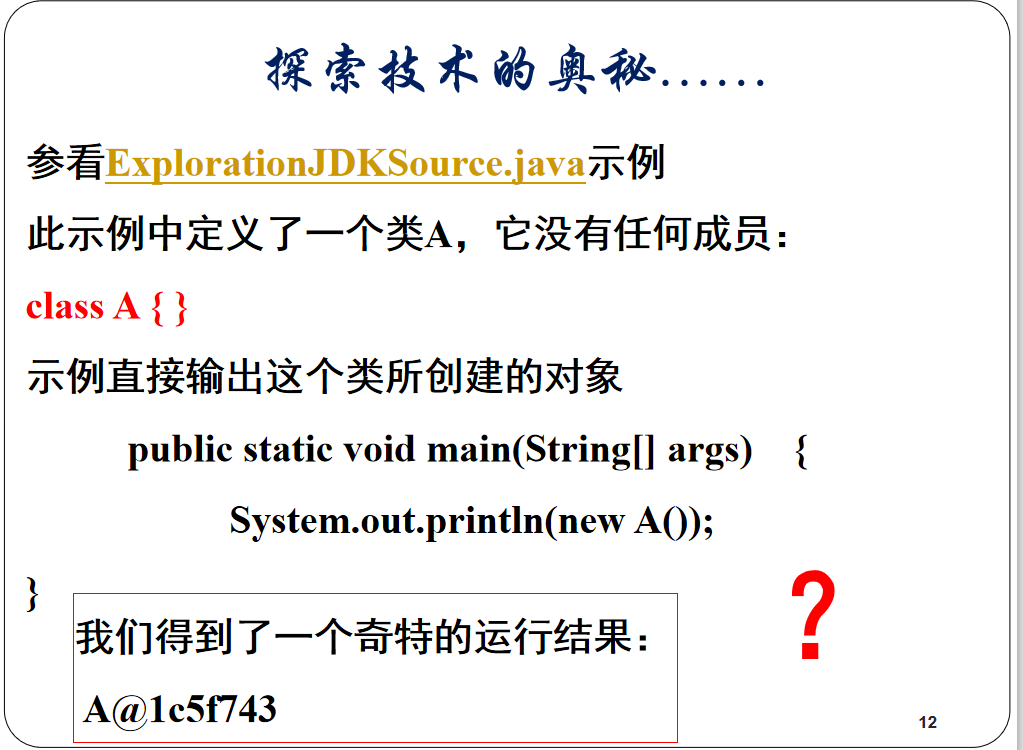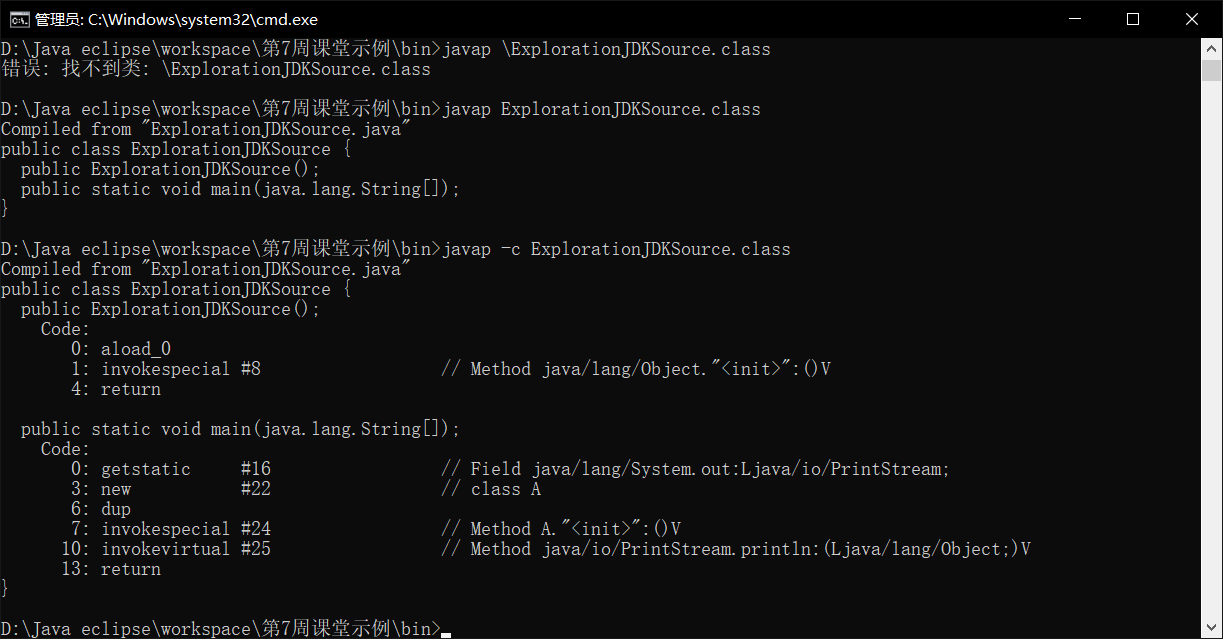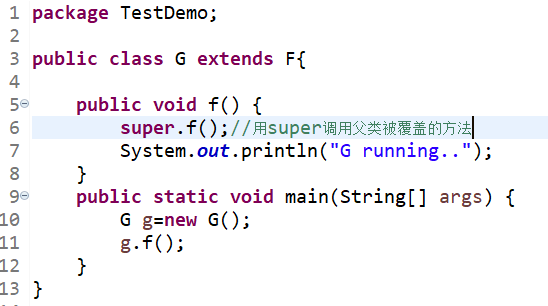一、super();调用基类构造方法

代码:
1 class Grandparent{ 2 public Grandparent(){ 3 System.out.println("GrandParent Created."); 4 } 5 public Grandparent(String string) { 6 System.out.println("GrandParent Created.String:" + string); 7 } 8 } 9 class Parent2 extends Grandparent 10 { 11 public Parent2() { 12 //super("Hello.Grandparent."); 13 System.out.println("Parent2 Created"); 14 // super("Hello.Grandparent."); 15 } 16 } 17 class Child2 extends Parent2 { 18 public Child2() { 19 System.out.println("Child2 Created"); 20 } 21 } 22 public class TestInherits { 23 public static void main(String args[]){ 24 Child2 c = new Child2(); 25 } 26 }
第一次运行结果:

第二次:(super语句放在第一句)

第三次运行结果:(super语句放在第二位)报错:super必须放在第一位
思索:为什么子类的构造方法在运行之前,必须调用父类的构造方法?能不能反过来?为什么不能反过来?
构造函数的作用是完成类的初始化,子类继承了父类的成员方法和成员变量,如果不首先调用,则从父类继承来的成员得不到初始化。
如果反过来调用,父类不知道子类的变量,并且子类中的部分从父类继承来的变量得不到正确的初始化,故顺序不能改变。
二、JVM的一种默认实现

请按照以下步骤进行技术探险:
(1)使用javap –c命令反汇编ExplorationJDKSource.class;
(2)阅读字节码指令,弄明白println()那条语句到底调用了什么?
(3)依据第(2)得到的结论,使用Eclipse打开JDK源码,查看真正被执行的代码是什么

原因:
前面示例中,main方法实际上调用的是: public void println(Object x),这一方法内部调用了String类的valueOf方法。 valueOf方法内部又调用Object.toString方法: public String toString() { return getClass().getName() +"@" + Integer.toHexString(hashCode()); } hashCode方法是本地方法,由JVM设计者实现: public native int hashCode();
三、
1 public class Fruit{ 2 public String toString() 3 { 4 return "Fruit toString."; 5 } 6 public static void main(String args[]) 7 { 8 Fruit f=new Fruit(); 9 System.out.println("f="+f); 10 System.out.println("f="+f.toString()); 11 } 12 }
注意最后两句句,一个字串和一个对象“相加”,得到以下结果:

原因分析:Fruit类覆盖了Object类的toString方法。在“+”运算中,当任何一个对象与一个String对象,连接时,会隐式地调用其toString()方法,默认情况下,此方法返回“类名 @ + hashCode”。为了返回有意义的信息,子类可以重写toString()方法。
四、方法覆盖
(1)覆盖方法的允许访问范围不能小于原方法。
(2)覆盖方法所抛出的异常不能比原方法更多。
(3)声明为final方法不允许覆盖。 例如,Object的getClass()方法不能覆盖。
(4)不能覆盖静态方法。
请自行编写代码测试以下特性:在子类中,若要调用父类中被覆盖的方法,可以使用super关键字。


运行结果:

五、多态
多态性的定义是:同一操作用于不同的类的实例,不同的类将进行不同的解释,最后产生不同的结果。即相同的一条语句,在不同的运行环境中可以产生不同的运行结果。
多态的最本质特征就是父类(或接口)变量可以引用子类(或实现了接口的类)对象。换句话说:子类对象可以被当成基类对象使用!
特别地,Java类库的最顶层类是Object。因此每个对象都可以赋值给Object变量。
子类对象可以直接赋给基类变量。 基类对象要赋给子类对象变量,必须执行类型转换, 其语法是: 子类对象变量=(子类名)基类对象名;
也不能乱转换。如果类型转换失败Java会抛出以下这种异常: ClassCastException
例子:
1 public class TestInstanceof 2 { 3 public static void main(String[] args) 4 { 5 //可以使用instanceof运算符判断一个对象是否可以转换为指定的类型: 6 //声明hello时使用Object类,则hello的编译类型是Object,Object是所有类的父类 7 //但hello变量的实际类型是String 8 Object hello = "Hello"; 9 //String是Object类的子类,所以返回true。 10 System.out.println("字符串是否是Object类的实例:" + (hello instanceof Object)); 11 //返回true。 12 System.out.println("字符串是否是String类的实例:" + (hello instanceof String)); 13 //返回false。 14 System.out.println("字符串是否是Math类的实例:" + (hello instanceof Math)); 15 //String实现了Comparable接口,所以返回true。 16 System.out.println("字符串是否是Comparable接口的实例:" + (hello instanceof Comparable)); 17 String a = "Hello"; 18 //String类既不是Math类,也不是Math类的父类,所以下面代码编译无法通过 19 //System.out.println("字符串是否是Math类的实例:" + (a instanceof Math)); 20 } 21 }
运行结果:

六、“类型转换”知识点考核
下列语句哪一个将引起编译错误?为什么?哪一个会引起运行时错误?为什么?
1 class Mammal{} 2 class Dog extends Mammal {} 3 class Cat extends Mammal{} 4 public class TestCast 5 { 6 public static void main(String args[]) 7 { 8 Mammal m; 9 Dog d=new Dog(); 10 Cat c=new Cat(); 11 m=d; 12 //d=m; 13 d=(Dog)m; 14 //d=c; 15 //c=(Cat)m; 16 } 17 }
解答:注释的三个语句皆会出现编译错误问题
12、14行为同一父类的子类对象不能相互转换,15行则是因为m对象之前已经被强转,所以不能再次转换。
七、子类和父类定义了一模一样的字段和方法
1 public class ParentChildTest { 2 public static void main(String[] args) { 3 Parent parent=new Parent(); 4 parent.printValue(); 5 Child child=new Child(); 6 child.printValue(); 7 8 parent=child; 9 parent.printValue(); 10 11 parent.myValue++; 12 parent.printValue(); 13 14 ((Child)parent).myValue++; 15 parent.printValue(); 16 } 17 } 18 class Parent{ 19 public int myValue=100; 20 public void printValue() { 21 System.out.println("Parent.printValue(),myValue="+myValue); 22 } 23 } 24 class Child extends Parent{ 25 public int myValue=200; 26 public void printValue() { 27 System.out.println("Child.printValue(),myValue="+myValue); 28 } 29 }
运行结果:
回答问题:
1. 左边的程序运行结果是什么? 2. 你如何解释会得到这样的输出? 3. 计算机是不会出错的,之所以得到这样的运行结果也是有原因的, 那么从这些运行结果中,你能总结出Java的哪些语法特性?
总结:
当子类与父类拥有一样的方法,并且让一个父类变量引用一个子类对象时,到底调用哪个方法,由对象自己的“真实”类型所决定,这就是说:对象是子类型的,它就调用子类型的方法,是父类型的,它就调用父类型的方法。 这个特性实际上就是面向对象“多态”特性的具体表现。
如果子类与父类有相同的字段,则子类中的字段会代替或隐藏父类的字段,子类方法中访问的是子类中的字段(而不是父类中的字段)。如果子类方法确实想访问父类中被隐藏的同名字段,可以用super关键字来访问它。 如果子类被当作父类使用,则通过子类访问的字段是父类的! 牢记:在实际开发中,要避免在子类中定义与父类同名 的字段。不要自找麻烦!——但考试除外,考试 中出这种题还是可以的。